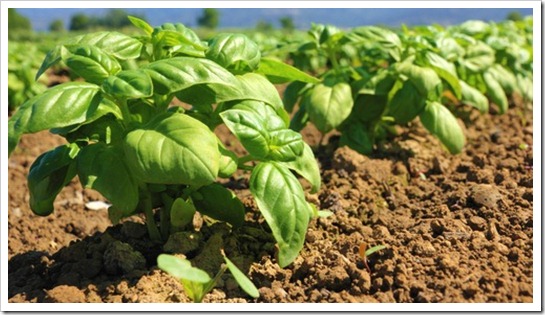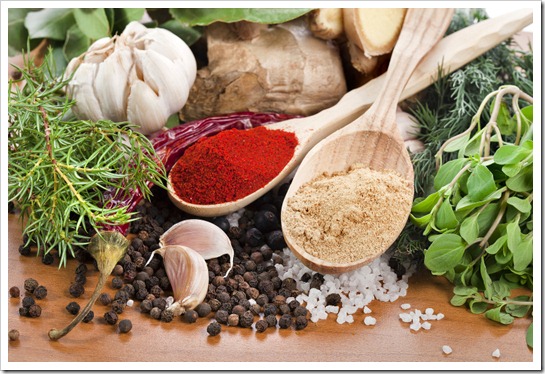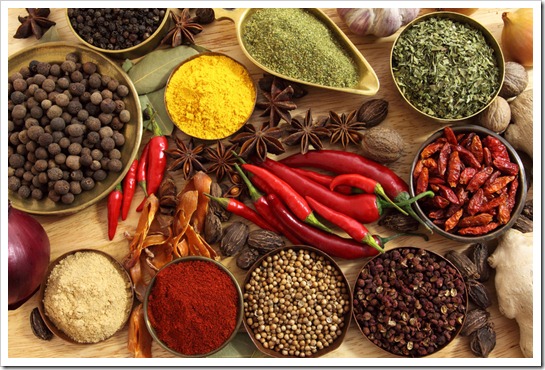Italian Herbs and Spices Posted by Serena on May 5, 2014 in Vocabulary
Italy is famous for its amazing cuisine, one of the most notable aspects of which is the simplicity of the recipes. Wonderful fresh ingredients, blessed by the Mediterranean sun, are combined in inventive ways, and flavoured with a range of traditional herbs and spices. Let’s find out what the most common of these spezie ed erbe aromatiche della cucina italiana are with a useful list that gives their names in both Italian and English:
aglio = garlic. Una testa d’aglio = a head of garlic, uno spicchio d’aglio (plural: due spicchi d’aglio) = a clove of garlic
alloro = bay. Una foglia d’alloro (plural: due foglie d’alloro) = a bay leaf
anice = anise. Semi di anice = anise seeds
anice stellato = star anise
basilico = basil. Un ciuffo di basilico (plural: due ciuffi di basilico) = a bunch of basil
cannella = cinamon. Cannella in stecche = cinnamon sticks, and cannella macinata = ground cinnamon
capperi = capers. Capperi sotto sale = salted capers, capperi sott’aceto = pickled capers
chiodi di garofano = cloves (literally: carnation nails). Un chiodo di garofano (plural: due chiodi di garofano) = a clove
cipolla = onion
dragoncello = tarragon
erba cipollina = chives
finocchio = fennel. Semi di finocchio = fennel seeds
ginepro = juniper. Bacche di ginepro = juniper berries
maggiorana = marjoram
menta = mint
 |
| … what would Italian cuisine be without the classic basilico? |
noce moscata = nutmeg. Noce moscata intera = whole nutmeg, noce moscata macinata = ground nutmeg
origano = oregano
papavero = poppy. Semi di papavero = poppy seeds
pepe = pepper. Pepe i grani = peppercorns, pepe macinato = ground pepper. Pepe nero = black pepper, pepe bianco = white pepper, pepe verde = green pepper, pepe rosa = pink pepper, pepe di cayenna = cayenne pepper
peperoncino = chili
prezzemolo = parsley
rosmarino = rosemary
salvia = sage
scalogno = shallot. N.B. lo scalogno, plural: gli scalogni
senape = mustard
sesamo = sesame
timo = thyme
vaniglia = vanilla
zafferano = saffron
N.B. in polvere = powdered, is also a commonly used expression for ground spices
These days it’s also possible to find other, more ‘exotic’ herbs and spices in Italian shops. Here are a few:
aneto = dill (weed)
cardamomo = cardamon
coriandolo = coriander. (N.B. usually coriander seeds, not coriander leaves)
cumino = cumin
curcuma = turmeric
kummel = caraway seeds. Allegedly this spice is now available in Italy, but I haven’t managed to get hold of it yet. Kummel is also known as carum carvi (its scientific name), cumino dei prati (cumin of the meadows), and cumino tedesco (German cumin)
paprica = paprika
pepe di Giamaica or pepe garofanato = allspices
zenzero = ginger. Zenzero fresco = fresh ginger, or radice di zenzero = ginger root, zenzero macinato = ground ginger. N.B. in Tuscany lo zenzero is the local name for the chilly pepper!
What are your favourite herbs and spices, is there anything that’s not included in our list that you like to use in your recipes?

Build vocabulary, practice pronunciation, and more with Transparent Language Online. Available anytime, anywhere, on any device.






Comments:
Irene:
“Un ciufffo di basilico” – tre “f”?
Geoff:
@Irene … a slip of the fffinger 😉 … thanks for pointing that out Irene, it’s now been corrected.
Jen:
I’m amazed just by looking at how many herbs and spices are used in modern day cooking! Also, I’m visiting Italy for a holiday soon, so these translations will help massively! Thanks!
Serena:
@Jen Salve Jen, mi fa piacere che il nostro blog ti sia utile. Auguri per la vacanza italiana.
A presto
Serena
Robin:
Grazie! Ho dimenticato molte parole perche non ho praticato il mio italiano. Ma penso che vuoi scrivere “chili”. “Chilly” sarebbe “freddo”.
Serena:
@Robin Grazie Robin, lo correggo subito!
Saluti da Serena
Robin:
Piacere Serena. Il tuo blog mi ha ispirato di comprare i pepperoncini. L’ho mangiato stasera con finocchio e prosciutto fatto dall’azienda LaQuercia. Delizioso! (Non posso parlare velocemente, ma se penso un po, posso dire le cose che voglio. Se ho sbagliato per favore mi correggi. Grazie.)
Gary:
Very intriguing, I go on holiday to Italy in a couple of weeks and this blog has really prepared me for the the brilliant Italian herbs and spices! Thanks for sharing!
Donia:
What do Italians call the “Italian spice mix” (Itailian seasoning)? I’ve looked all over for the name but couldn’t find it.
Serena:
@Donia Salve Donia e benvenuta!
You asked: What do Italians call the “Italian spice mix” (Italian seasoning)?
Well, the general name is ‘misto di spezie’ (spice mix), but we don’t have an ‘Italian spice mix’ as such. We have misto di spezie per carni (for meat), per pesce (for fish), per patate arrosto (for roast potatoes), etc. You will have to compare the ingredients with your favourite ‘Italian seasoning’ and find the closest one.
Saluti da Serena
Dee:
My father came from Gaeta Italy and made home made sausages and used the spice bitratta, would that be coriander seeds in english ?
Gina:
I’m from Veneto but have lived in Canada for 50 years. Something I remember from my youth is “tortollino”. An egg, flour and “erba mara” mixture which was cooked as a polpetta (fried), and had a distinctive amaro taste from the leafy plant. I managed to get some “erba mara” seeds and still treat myself to a tortolleto every year. Would you know what this plant is called in English? It resembles a camomile plant but is not that. Thank you.
Musa:
Thank you so much for your informations
I learned a lot from you